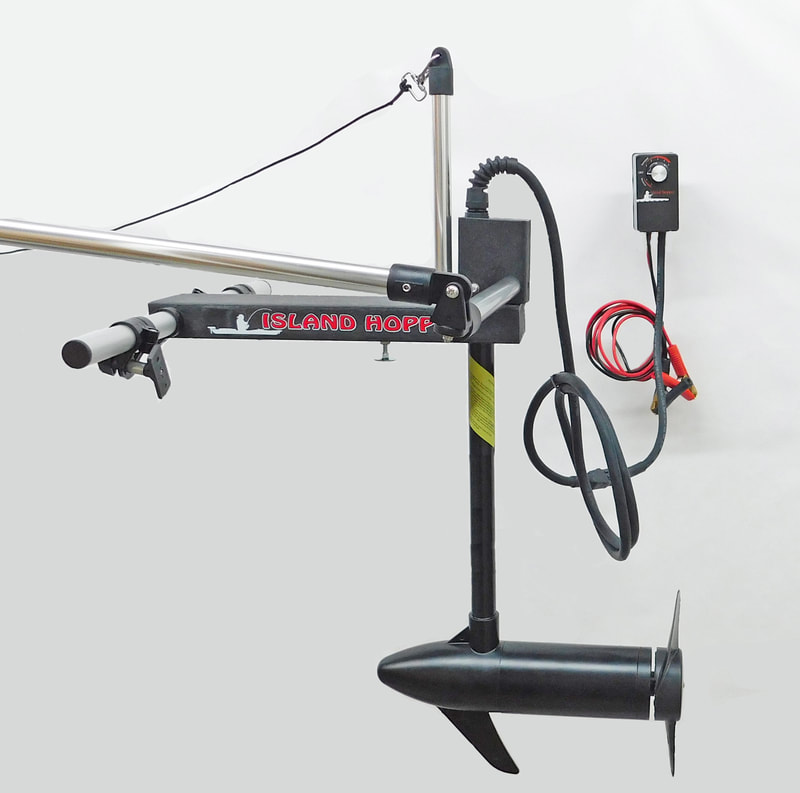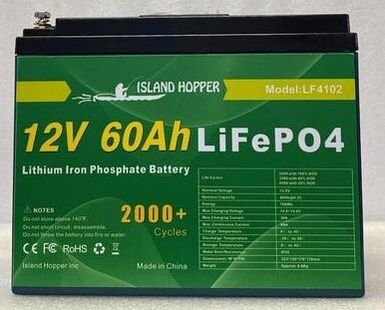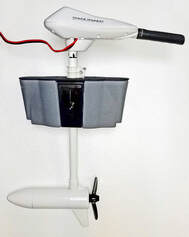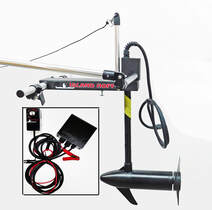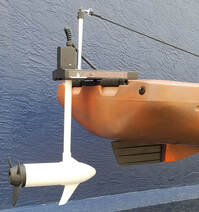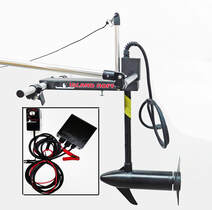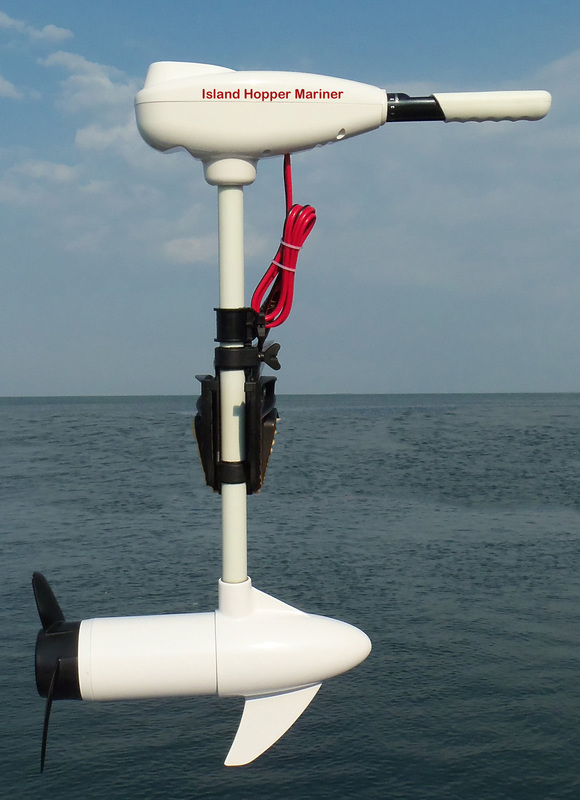Information Wizard
$1.00
In Stock
Buying a motor for your kayak is often a one-time purchase that will last you a very long time. We will cover the following in-depth: Trolling motors(Conventional-Variable – Brushless)& Batteries(Deep Cycle-Lifepo4). Conventional Trolling Motors These are the most commonly used motors to motorize a kayak. They are cost-effective and are equipped with older technology using […]
Categories:
UncategorizedSKU:
InfoBuying a motor for your kayak is often a one-time purchase that will last you a very long time.
We will cover the following in-depth: Trolling motors(Conventional-Variable – Brushless)& Batteries(Deep Cycle-Lifepo4).
Conventional Trolling Motors
These are the most commonly used motors to motorize a kayak. They are cost-effective and are equipped with older technology using a basic 5 forward / 2 reverse speeds mechanical switch. They are primarily designed to bring you quickly to your desired destination or fishing hole, and or reposition your kayak when currents or wind blow you off course.
Understanding Conventional Speeds:
– 1st and 2nd speeds are designed for short bursts only, not exceeding 15-minute intervals at a time. “Not for trolling”, as it will damage these two speeds.
– 3rd speed is for covering larger areas while conserving battery.
– 4th speed is for traveling longer distances faster.
– 5th speed is for when speed is required, such as a change in the weather, current, chop waters, or an emergency; getting to safety or shore quickly.
Battery Compatibility: Deep Cycle Marine, AGM, and GEL batteries are best suited to use with conventional trolling motors and are not recommended their use with Lithium-Ion / LiFePO4 batteries (Read more below)
Variable Speed Trolling Motors
Is it one of the most improved technologies today? Boaters and kayakers are gravitating to trolling motors with variable speeds due to their many benefits.
Benefits of Variable Speed Include:
– Infinite Speed Range of “0-100 speed forward and reverse”, which allows for trolling at very low speeds for hours without affecting any speeds of the motor.
– A Micro Processer aka (Pulse Width Modulator) to increase battery range 3 to 4 times, allowing for hours of continuous trolling.
– Controlled Amperage provides steady trolling in currents and wind while conserving battery at 95% efficiency.
– Integrated Electronic Board System senses over and undercharge of voltage, eliminates voltage spikes, 95% efficiency in power and torque.
– Soft start: no spooking of fish while trolling and lighter in weight than conventional trolling motors.
Battery Compatible: Lithium-Ion / LiFePO4, Deep Cycle Marine, AGM, and GEL batteries.
Lithium Iron – LiFeP04 Compatible Trolling Motors –
Variable Speed motors are often used with LiFeP04 battery because their circuit board design was built to regulates the voltage and allows speed adjustments in fractional increments as such, from 1/4 to 5 mph. These motor includes heavy gauged wire, and require an auto-reset fuse, and lithium-ion plug because they are capable of handling high amperage of 60 to 200 amp LiFePO4 batteries.
Brushless Motors
600 watt (2.0hp / 80# of thrust) and 930 watt (3.0hp / 120# thrust of thrust) variable speed trolling motor called Vortex® Trolling Motor
Vortex® Trolling Motor is the result of matting a 3-phase DC electric motor with an outdrive to deliver torque and higher speed than other trolling motors.
Brushless are built using rare earth magnets, designed to deliver constant torque and SPEED to power the heaviest of kayaks.
Brushless motors, draw 1/3 of the power of a conventional trolling motor, therefore, requiring a smaller and lighter battery to operate.
Travel time per charge yields approx. 8 hours at lower speeds and 2 hours at higher speeds depending on battery type and size.
Vortex® Trolling Motor Sea Trial with Hobie® Mirage® Drive Outback Kayak
Flat Water
12vdc @35a battery consumption per hour = 6 mph 600 watts
24vdc @20a battery consumption per hour = 6 mph 930 watts
5 mph Winds 0 chop + 0 current
12vdc @15a battery consumption per hour = 4 mph 600 watts
24vdc @10a battery consumption per hour = 4.6 mph 930 watts
15 mph Wind Light Chop + Current (2mph)
12vdc @18a battery consumption per hour = 2.3-2.8 mph 600 watts
24vdc @14a battery consumption per hour = 3.0-3.4 mph 930watts
Battery Consumptions
8 hours at low speed and 2 hours at top speed
Calculations for speed and battery consumption will vary per kayak and may differ in results and or performance.
A small reduction in speed will substantially decrease battery consumption while maintaining nearly the same speed value
A point of interest, the more amperage increase, will not necessarily increase speed but will increase torque.
Choosing a Motor.
Choosing a motor for your kayak is determined mostly by the type of species you’re after, and the body of water you are kayaking.
There are many brands of kayaks that lend themselves to adding a trolling motor to them: Hobie® Pro Angler, Ocean Kayak, Native Watercraft, Feel Free, Old Town, Vibe Kayak, Bonafide Kayak, Brooklyn Kayak, 3 Waters Kayak, Ascend Kayak, Pelican kayak, and so many more.
These kayaks are mostly for fishing and tend to be wide and roomy. Some of them are designed to pedal or paddle, but the most common issue amongst them, is that they move like a brick across the water.
Whether you’re kayak fishing in lakes, rivers, estuaries, or the sea, you’ll need to choose between a conventional or a variable-speed trolling motor.
The right trolling motor for your application is imperative in saving you money from the get-go.
Regardless of the name brand, all conventional trolling motors operate using the same principles and design. They have a rheostat to control speed. This means, using the trolling motor to reach your desired location at mid to high speed, and once there, you use one of the low speeds intermittently to stay within range of your fishing spot.
Variable Speed Controlled Trolling Motors are similar in looks but differ in electronic design. They are controlled by a PWM, which is an electronic voltage regulator and speed controller. Variable-speed trolling motors equipped with PWM is designed to troll for hours. Their speed is infinite and can be dialed from as low as 1/4mph to 4mph, while at the same time, conserves battery energy by 3-4 times longer than conventional trolling motors. Therefore, it is important to know your type of fishing and what type of fish you’re targeting when choosing a trolling motor.
Motor Sizing
It is important to size a trolling motor to your kayak, since, too small of a trolling motor may prove ineffective. On land, 10 mph wind is a light breeze; add that same 10 mph breeze over a body of water while kayaking, and that breeze is no longer enjoyable. In calm waters, a 30 lbs. thrust trolling motor may be sufficient to push a wide and heavy kayak, but add a 10 mph breeze and the 30lb. trolling motor is underpowered, kayaking becomes challenging and may take forever to bring you back to your launch site. In this case, a 46lb. thrust kayak trolling motor would be a much better choice for when you’ll need the power to move across a body of water fast: your kayak will have the torque required to bring you back safely on land and in a hurry.
Light currents are common on any large bodies of water, and whether kayaking in a one-person kayak or tandem kayak, such as Vibe Sea Ghost 130T, Feel Free II Lure, Hobie T17, Ocean Kayak Malibu, etc., they will require at the very least a 55lb thrust kayak trolling motor, because pedaling or paddling is definitely a challenge and tiresome when trying to do both fish and travel. Moreover, when fishing in a large kayak, especially saltwater, a 55lbs thrust kayak trolling motor is recommended because these vast waterways require dealing with incoming and outgoing currents that at times will exceed 2 mph, with light swells and a 10mph wind. Sometimes, we even suggest Brushless motors when speed is more important than trolling.
Batteries
Batteries play a very important role in motorized kayaking. A battery to a kayak motor is what a gas tank to a car. The bigger the battery the longer you can troll, fish, and go places: just as the bigger the gas tank in a car, the longer range one can travel without refueling. Therefore, the bigger the kayak the more energy will be required from the battery.
Understanding Lithium-Ion (LiFePO4) Battery & Their Effect On Conventional Trolling Motors vs Trolling Motors with Intergraded Circuit Board
LiFePO4 batteries were designed to be light weight and pack more energy. LiFePO4 batteries were engineered to store as much voltage from solar panels.
The stored voltage is unregulated and will burnout conventional trolling motors or shorten their lifespan because the collected volts are too high (+18 volts = 12.8 – 16.0 volts DC), whereas conventional trolling motors operate on regulated 12 volts. Therefore, to regulate the LiFePO4 battery voltage output, a trolling motor requires an intergraded circuit board to control speed and regulate the voltage, along with a heavy gauged battery cable, lithium-ion plug, and an auto reset fuse.
Trolling motors with intergraded circuit boards tend to have a longer lifespan and extended fishing time while kayaking.


